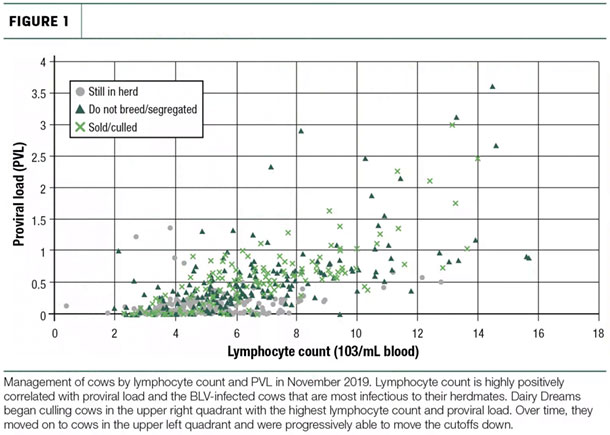Control and even eradication of bovine leukosis, caused by bovine leukemia virus (BLV), is possible in U.S. dairy herds dedicated to prioritizing diagnostic testing, acting on results and employing regular management practices that reduce the risk of transmission.
The “test and cull” method employed by other countries that have eradicated the disease is not feasible in the U.S., given that almost half of U.S. dairy cows are currently infected.
Since 2018, Dr. Don Niles, dairy operations manager for Pagel Family Businesses, along with the team at Dairy Dreams in Casco, Wisconsin, partnered with researchers at our cooperative and Michigan State University to develop a leukosis eradication program. The resulting program attacks BLV from several angles, including multipronged diagnostic testing, strict management decisions based on diagnostic results and employing management practices to reduce the risk of transmission and new infections. Throughout the study, researchers continually analyzed and evaluated diagnostic data, working collaboratively with the Dairy Dreams team to adjust the protocol based on observations from research and from the farm.
The diagnostic approach included individual blood lymphocyte counts in combination with the milk leukosis Enzyme-Linked ImmunoSorbent Assay (ELISA) test and the BLV Super-Shedders (SS1) polymerase chain reaction (PCR) assay. The BLV SS1 PCR was recently developed by our cooperative and MSU in response to previous MSU research that identified and described cows known as BLV “super-shedders.” These susceptible cows shed exponentially more BLV than their herdmates, contributing disproportionately to whole-herd shedding and making them the most contagious. Therefore, super-shedders were recognized as a critical control point in herds committed to controlling BLV.
Dairy Dreams was first able to use an automated cell counter to screen cows by the number of lymphocytes in their blood. Lymphocytes are a type of white blood cell that BLV preferentially infects, and an abnormally high proportion of lymphocytes in the blood is an established marker of advanced disease in cows that are able to spread more infected cells to their herdmates.
After this initial screening, Dairy Dreams began weekly testing of fresh cows by blood ELISA, and any BLV-positive samples were tested using the BLV SS1 PCR. The ELISA test measures the concentration of antibodies in a cow’s milk or blood specific to BLV. If the cow’s immune system has recognized and is actively responding to the threat of BLV, the cow will yield a positive test result. Utilizing ELISA testing of DHI milk samples can be a convenient and cost-effective method; however, it only provides a semi-quantitative value (higher value indicates a “more positive” cow) and cannot distinguish between cows that are super-shedders and those that are not.
In contrast, the BLV SS1 PCR measures proviral load (PVL), which essentially indicates how many viruses a cow is shedding. When a cow is infected with BLV, the virus hijacks a cow’s lymphocytes and incorporates its own DNA into the cow DNA, allowing detection in the blood. PVL, detected by the BLV SS1 PCR, is expressed as the ratio of the virus DNA to cow DNA, and a PVL greater than 1.0 is considered high. The BVL SS1 PCR is unique in that it is a rapid, accurate and cost-effective indication of how contagious a cow is.
At the onset of the eradication program in 2018, Dairy Dreams aggressively culled any cow with a lymphocyte count greater than 10,000 cells per milliliter of blood. Likewise, cows with a PVL of greater than 0.5 (Figure 1) were either culled or sold for dairy with “known BLV status” communicated prior to the sale.

In 2019, they expanded their efforts, and any cow with a detectable PVL below the herd threshold was bred with beef semen. Since then, these cows have been coded Do Not Breed (DNB) and culled when production reaches cull level. Additional eradication efforts include testing heifers prior to entering the milking herd and ongoing monitoring including retesting all previously negative cows at freshening. Any ELISA-positive animals are then tested by SS1 PCR.
Along with these testing strategies, the Dairy Dreams staff follow several management practices to reduce transmission. They utilize Pulse NeedleFree system in place of hypodermic needles, which are thought to be the main route of transmission in today’s U.S. dairy herds. Palpation/breeding sleeves are changed between all heifers during reproductive exams. They are also changed after known BLV-positive cows, which are identified with a zip-tie in their eartag. Additionally, the herd has a very effective fly control program in place.
Through this comprehensive approach, the PVL threshold has been incrementally decreased each quarter. Dairy Dreams continues to aggressively attack BLV and is now culling all cows with a detectable PVL. Currently, less than 2% of the herd has any detectable BLV.
Regarding the progress of BLV eradication in the herd, Dr. Niles shared, “The rapid progress using the adaptive strategy, including quarterly reports and phone consultations with CentralStar and MSU, was impressive. The knowledge and consultation shaped our program and proved to be essential in our BLV herd eradication program.”
Although the “test and cull” approach proved effective in eradicating leukosis in countries that started when prevalence was low, the U.S. needs more creative and comprehensive strategies to attack BLV. The collaborative effort at Dairy Dreams, which is based on the core strategy of identifying and removing the most contagious cows from the herd, has proven to be an effective method producers can employ to meet individual herd goals while reducing or eliminating herd prevalence of this costly disease.







